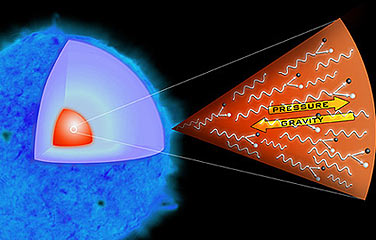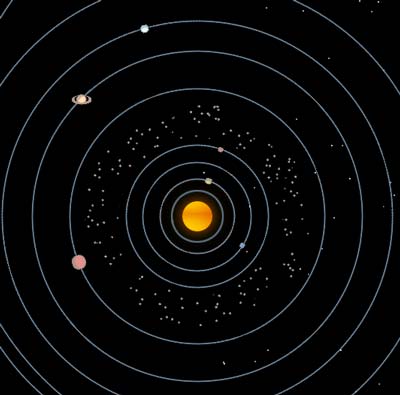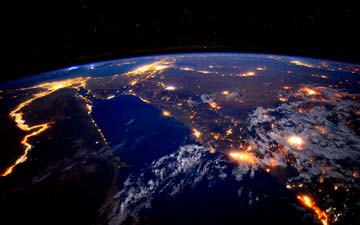Astronomers Report Largest Stellar Explosion
by Dennis Overbye
5/7/07
Kaboom, indeed.
In a cascade of superlatives that belies the traditional cerebral reserve of their profession, astronomers reported Monday that they had seen the brightest and most powerful stellar explosion ever recorded.

© NASA / CSC / M. Weiss
HOW IT HAPPENED The cores of massive stars can produce so much gamma-ray light that some of the energy from the radiation is converted into particle and anti-particle pairs. The resulting drop in energy causes the star to collapse under its own huge gravity. After this violent collapse, runaway thermonuclear reactions ensue and the star explodes, spewing the remains into space.
The cataclysm — a monster more than a hundred times as energetic as the typical supernova in which the more massive stars end their lives — might be an example of a completely new type of explosion, astronomers said. Such a blast — proposed but never seen — would explain how the earliest and most massive stars in the universe ended their lives and strewed new elements across space to fertilize future stars and planets.
“It is quite possibly the most massive star that has ever been seen to explode,” said Nathan Smith of the University of California, Berkeley, who estimated the star as “freakishly massive,” about 150 times the mass of the Sun.
“We’re really excited about this,” Dr. Smith said. “If it really is what we think it is, it forces us to rethink how massive stars die.” He led a team of astronomers from the University of California, Berkeley, and the University of Texas, who have submitted a paper about the supernova to the Astrophysical Journal and discussed the results in a news conference from NASA headquarters today.
Astronomers have been following the star since last September, when it was discovered in a galaxy 240 million light years away in the constellation Perseus by Robert Quimby, a University of Texas graduate student, who was using a small robotic telescope at McDonald Observatory near Fort Davis, Tex., to troll for supernovas.
The star bears an eerie resemblance to one in our own galaxy, Eta Carinae, which has been burbling and bubbling in the last few centuries as if getting ready for its own outburst. The observations suggest that the troubled and enigmatic star, thought to weigh in about 120 solar masses, could blow up sooner than theorists had thought. Mario Livio a theorist at the Space Telescope Science Institute who was not involved in the research, said the death of that star could be “the most spectacular star show in history.”
Cautioning that theorists still do not know for sure what caused the explosion announced today, Dr. Livio said, “Here we have the brightest supernova we have ever observed and we don’t know the explosion mechanism. It doesn’t get any more exciting for a theorist.”
Such supermassive stars are extremely rare in the modern universe but are believed to have been common among the first stars that formed when the universe was less than a billion years old.
“We may be witnessing an example in the local universe of a process quite common in the early universe,” said Alex Filippenko, a team member also from the University of California, Berkeley. The explosion raises astronomers hopes that the next generation of bigger telescopes, like NASA’s coming James Webb Space Telescope, will be able to detect these stars by their explosions.
“Ironically, we might first detect the first generation of stars by their deaths,” Dr. Filippenko said.
Supernovas come about in two basic ways: explosions of small stars about one and half times the mass of the Sun, known as White Dwarfs, and which are uniform enough to serve as cosmological distance markers; and the collapse of the cores of more massive stars into black holes or neutron stars when their thermonuclear fuel has run out.
The astronomers first suspected that the supernova’s dramatic output was caused by the shock wave of a white dwarf exploding into a dense cloud of hydrogen. When observations with the Chandra X-ray Observatory failed to find enough X-rays to support that scenario, the group was forced to consider the alternative that the luminosity was produced by the decay of radioactive nickel. But to match the observations, the star would have to produce 22 solar masses of radioactive nickel — way off scale for the core collapse model.
“To get more than 20 solar masses of nickel, you need one heck of a huge star,” Dr. Smith said. In this case, he said, “The core did not collapse, it was blown to smithereens.”
In desperation, the astronomers turned to a theory proposed nearly 40 years ago by Zalman Barkat of the Hebrew University of Jerusalem and his colleagues. The intensity of radiation in the cores of such supermassive stars could be so great, they said, that pairs of electrons and their antimatter opposites, positrons, would be created.
“That is bad news for the star,” Dr. Livio said, explaining that the disappearance of the radiation would sap the core’s energy and cause the star to collapse. But in this case the star still has plenty of fuel and blows up.
“The core is still composed of explosive oxygen,” explained Craig Wheeler of the University of Texas and another of the paper’s authors. “The oxygen ignites and blows the star to smithereens with no remnant, no black hole left.”
The “pair instability,” as it is known, is particularly relevant to the very first stars, made of pristine hydrogen and helium fresh from the furnace of the big bang. According to theory, they could grow to large size because they lacked the heavier elements, dubbed “metals,” which are very efficient in catching light and thus make modern stars more susceptible to fragmenting during their formation, limiting their sizes. Those metals have been produced by thermonuclear reactions in stars.
It is very convenient, as Dr. Smith and his colleagues pointed out, that the pair mechanism produces an explosion that scatters all the star’s ashes enriched by thermonuclear processing, outward into space instead to down into a black hole.
Dr. Filippenko said, “It effectively fertilizes the material from which second and third generation was made.
The astronomers stressed that this diagnosis, while thrilling, was far from definite. Dr. Wheeler said, “We don’t have a good alternative explanation for the source of luminosity, but we need some smoking gun.”
The star is now going behind the Sun but when it comes out, more observations are planned. The results of those observations could also have implications for those later generation stars, like Eta Carinae.
Astronomers had presumed that heavy stars shed heavy envelopes of hydrogen by winds and burps before reaching the final stage where they implode into black holes. It could be, however, that the most massive stars just can’t shed mass fast enough, Dr. Smith said.
Eta Carinae could blow up sooner than we thought, Dr. Smith said, noting that it could be tomorrow, it could be thousands of years from now. Astronomers have no way of telling.
Even if it did blow as the new supernova did last fall, at a distance of around 7,500 light years, Eta Carinae would be unlikely to cause any serious harm to Earth, astronomers said. The explosion would be visible in the daylight and at night you would be able to read a book by its light.
As for extinguishing life on Earth, “We can sleep quietly tonight,” Dr. Livio said, adding that the puzzle of the supernova would keep astronomers "awake for quite a while."
 See an animation of the movement of planets in our solar system.
See an animation of the movement of planets in our solar system. See amazing views from space
See amazing views from space